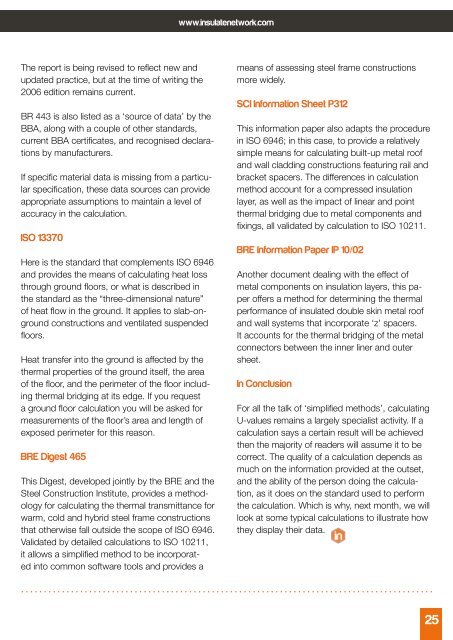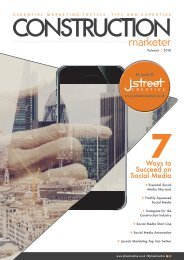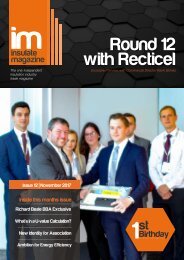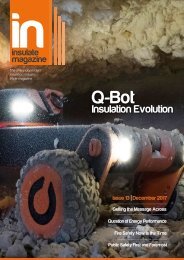Insulate Magazine Issue 11 - October 2017
When is an Insulation Manufacturer not and Insulation Manufacturer headlines the October issue of Insulate Magazine. Possibly the best front cover for an Insulation publication EVER.
When is an Insulation Manufacturer not and Insulation Manufacturer headlines the October issue of Insulate Magazine. Possibly the best front cover for an Insulation publication EVER.
You also want an ePaper? Increase the reach of your titles
YUMPU automatically turns print PDFs into web optimized ePapers that Google loves.
www.insulatenetwork.com<br />
The report is being revised to reflect new and<br />
updated practice, but at the time of writing the<br />
2006 edition remains current.<br />
BR 443 is also listed as a ‘source of data’ by the<br />
BBA, along with a couple of other standards,<br />
current BBA certificates, and recognised declarations<br />
by manufacturers.<br />
If specific material data is missing from a particular<br />
specification, these data sources can provide<br />
appropriate assumptions to maintain a level of<br />
accuracy in the calculation.<br />
ISO 13370<br />
Here is the standard that complements ISO 6946<br />
and provides the means of calculating heat loss<br />
through ground floors, or what is described in<br />
the standard as the “three-dimensional nature”<br />
of heat flow in the ground. It applies to slab-onground<br />
constructions and ventilated suspended<br />
floors.<br />
Heat transfer into the ground is affected by the<br />
thermal properties of the ground itself, the area<br />
of the floor, and the perimeter of the floor including<br />
thermal bridging at its edge. If you request<br />
a ground floor calculation you will be asked for<br />
measurements of the floor’s area and length of<br />
exposed perimeter for this reason.<br />
BRE Digest 465<br />
This Digest, developed jointly by the BRE and the<br />
Steel Construction Institute, provides a methodology<br />
for calculating the thermal transmittance for<br />
warm, cold and hybrid steel frame constructions<br />
that otherwise fall outside the scope of ISO 6946.<br />
Validated by detailed calculations to ISO 102<strong>11</strong>,<br />
it allows a simplified method to be incorporated<br />
into common software tools and provides a<br />
means of assessing steel frame constructions<br />
more widely.<br />
SCI Information Sheet P312<br />
This information paper also adapts the procedure<br />
in ISO 6946; in this case, to provide a relatively<br />
simple means for calculating built-up metal roof<br />
and wall cladding constructions featuring rail and<br />
bracket spacers. The differences in calculation<br />
method account for a compressed insulation<br />
layer, as well as the impact of linear and point<br />
thermal bridging due to metal components and<br />
fixings, all validated by calculation to ISO 102<strong>11</strong>.<br />
BRE Information Paper IP 10/02<br />
Another document dealing with the effect of<br />
metal components on insulation layers, this paper<br />
offers a method for determining the thermal<br />
performance of insulated double skin metal roof<br />
and wall systems that incorporate ‘z’ spacers.<br />
It accounts for the thermal bridging of the metal<br />
connectors between the inner liner and outer<br />
sheet.<br />
In Conclusion<br />
For all the talk of ‘simplified methods’, calculating<br />
U-values remains a largely specialist activity. If a<br />
calculation says a certain result will be achieved<br />
then the majority of readers will assume it to be<br />
correct. The quality of a calculation depends as<br />
much on the information provided at the outset,<br />
and the ability of the person doing the calculation,<br />
as it does on the standard used to perform<br />
the calculation. Which is why, next month, we will<br />
look at some typical calculations to illustrate how<br />
they display their data.<br />
25













